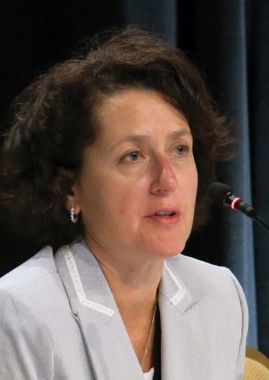SAN FRANCISCO – Breast cancer survivors shared several body composition characteristics associated with increased cardiac risk and were referred for cardiac consultation most commonly for a high body mass index, an elevated LDL* level, insufficient exercise, and exposure to anthracycline, two separate studies found.
In the first study, kinesiologists measured various characteristics in 3,674 nononcology female patients and compared them with measurements in 740 women in a breast cancer survivorship clinic who were stratified into 8 groups according to the type of treatment they received. All breast cancer patients underwent surgery: 41 women had surgery alone, 13 also underwent chemotherapy, 51 had surgery and radiotherapy, and 48 had surgery and hormone therapy. Most cancer survivors underwent multiple therapies: surgery, chemotherapy, radiation, and hormone therapy in 244; surgery, radiation, and hormone therapy in 207; surgery, chemotherapy, and radiation in 83; and surgery, chemotherapy, and hormone therapy in 30, David H. Jones and his associates found.
Statistically significant differences were seen between the control group and five of the eight treatment groups. Compared with the control group, patients who underwent surgery, chemotherapy, radiation, and hormone therapy had significantly higher mean diastolic blood pressure (77 vs. 74 mm Hg), mean systolic blood pressure (128 vs. 123 mm Hg), mean arterial pressure (94 vs. 90 mm Hg), A faster mean heart rate (77 vs. 73 beats per minute), a higher percentage of body fat (37% vs. 34%), and a greater waist circumference (88 vs. 85 cm), Mr. Jones reported in a poster at a breast cancer symposium sponsored by the American Society of Clinical Oncology.
Patients who underwent surgery, radiation, and hormone therapy also had a higher mean systolic blood pressure compared with controls (130 mm Hg), a higher mean arterial pressure (94 mm Hg), and greater body fat (37%). Patients who underwent surgery, chemotherapy, and radiotherapy had a higher mean systolic blood pressure (129 mm Hg), mean arterial pressure (94 mm Hg), heart rate (79 bpm), and body fat (38%) compared with controls, reported Mr. Jones of Ville-Marie Medical Center, Montreal.
Patients treated with surgery alone had a higher body mass index (29 vs. 26 kg/mm2), body fat percentage (39%), and waist circumference (90 cm) than did controls. Patients who underwent surgery and chemotherapy had significantly less mean muscle mass compared with controls (9.6 vs. 10.1 kg).
Previous studies have associated these body composition characteristics with increased risk for cardiovascular diseases and metabolic problems, Mr. Jones noted.
In the second study of 365 women with nonmetastatic breast cancer seen at a survivorship center in 2006-2012, 13% already were being followed by a cardiologist, 21% were referred to cardio-oncology after their initial visit to the survivorship center, and 66% were not referred, Jennifer R. Klemp, Ph.D., and her associates found.
Patients who were not referred had an average of four risk factors for cardiovascular disease, significantly fewer than the average of six cardiovascular risk factors in patients referred to cardio-oncology and those already seeing a cardiologist, reported Dr. Klemp, director of cancer survivorship at the University of Kansas, Westwood.
The risk factors considered in the study included exposure to cardiotoxic breast cancer treatment as well as traditional risk factors: a BMI greater than 25, diabetes; hypertension, an elevated HDL level, a history of smoking, a family history of an MI before age 60 years, and exercising fewer than 150 min/wk. Breast cancer treatment–related risk factors included an ejection fraction less than 50%; anti-hormone therapy; use of tamoxifen, anthracycline, or Herceptin (trastuzumab); and left chest wall radiation.
Among patients referred to cardio-oncology, 92% showed up. Most often they received additional diagnostic tests, changes in medications, or return visits for follow-up.
"These findings demonstrate the need to determine how to include treatment-related risk factors along with traditional cardiovascular risk factors in assessing and managing cardiovascular risk in breast cancer survivors," Dr. Klemp said.
Mr. Jones and Dr. Klemp reported having no relevant financial disclosures. Most of Dr. Jones’ associates were employees or leaders of Ville-Marie Medical Center.
On Twitter @sherryboschert
*Correction, 11/20/2013: A previous version of this article misstated one of the symptoms for both increased cardiac risk and increased risk for cardio-oncology referrals.



